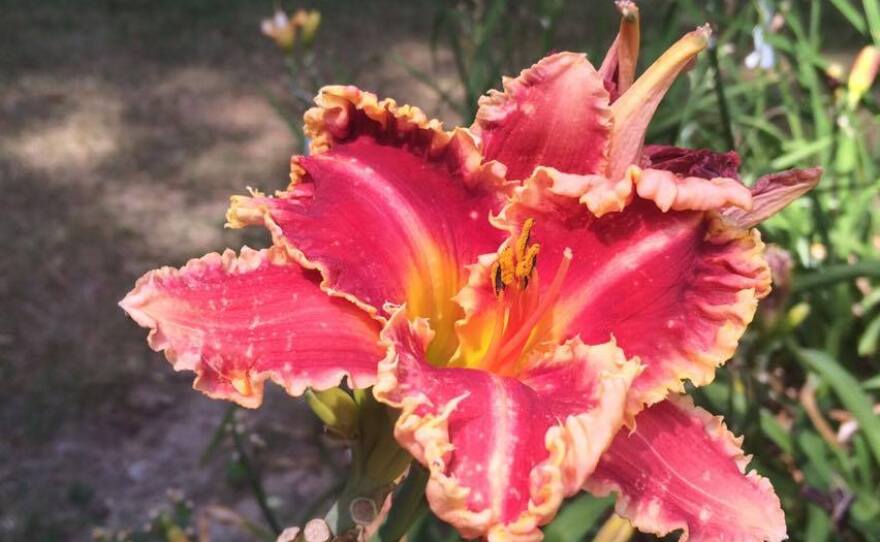Nowadays we can improve just about anything, from the smartphone in our pocket to the latest gaming system. Even basic things like plants are no exception. For roughly six decades Dave Niswonger has been improving the appearance of plants. He’s hybridized everything from daylilies to daffodils. But his speciality are irises, of which he’s introduced nearly 300 varieties.
“It’s partly an art as well as being scientific knowledge in breeding,” Niswonger said. “You just get a sense of what a certain plant has to offer in a cross.”
Niswonger does most of his hybridizing from his home in Cape Girardeau. His garden is spacious, lined with rows of stunning irises and blooming daylilies. Each flower is a Niswonger exclusive, from the shape of the petal right down to the color.
“This is a seedling of mine,” Niswonger said. “I’m trying to get a round form with a gold edge. And that’s one of my seedlings that I developed.”
But gardening has always been second nature to Niswonger. He learned the basics of growing plants on his grandfather’s farm in Patton, Missouri.
“In the summertime when the school [would] break, I would go up to Patton, Missouri to my grandpa’s house and stay with him on the farm, and help him pitch hay or whatever jobs need[ed] to be done,” Niswonger said.
At six, he was growing vegetables. By 12, he tried grafting a sweet cherry tree to a wild cherry tree.It didn’t work, but it fueled an insatiable appetite for hybridizing. Since then, he’s gone on to hybridize nearly 40 varieties of daylilies, 30 daffodils and 8 gladiolus.
Magic Behind Hybridizing
So how does hybridizing work? Niswonger said he chooses a characteristic he wants to improve like adding ruffles or lace.
“That becomes your goal,” Niswonger said. “Or you might want to develop a new color that you don’t even have.”
Then he finds two plants he wants to hybridize. He takes the good characteristic of one plant and crosses it with another that lacks those traits. In order to cross it, Niswonger uses plant tweezers to pluck the anther from the first flower, and then rubs it against the end of the second plants pistil.
“That’s all there is to it,” Niswonger said. “ It’s nothing magic about it. Then the seed pods when they start to crack open and the seed is mature, I come along and pick up the seeds, and put [a] tag with the seed so I know the parents.”
The end result should create a flower that’s an improvement of its parents. But that could take several generations. Hybridizing is a trial and error process. Sometimes it works, and other times not so much.
“You don't know which one's are fertile, and which one's are not,” Niswonger said. “You just have to experiment and then sometimes a certain plant will accept pollen from certain plants and not from others.”
Cape Girardeau’s Best Kept Secret
Niswonger is one of Cape Girardeau’s best kept secrets, but in plant circles abroad he’s a big deal, because of his iris contributions.
“He calls me on the phone,” said Niswonger talking to his friend Vernon Meyer from Altenburg, Missouri. “He says ‘Dave, are you the Great American Hybridizer?’ I said, ‘what? What are you talking about?’”
Yes, the Great American Hybridizer. During a trip to Germany, Meyer met a man who was an iris expert. He had close to 300 varieties of irises in his collection, but most of them were outdated. When Meyer told him the man’s story, Niswonger decided to send him newer varieties of irises.
A few weeks later, Meyer got a letter from the man who was in disbelief that he knew Niswonger. In his letter, he referred to him as “the Great American Hybridizer.” As it turns out, Niswonger’s award-winning iris “Brown Lasso” found its way into East Germany.
“I introduced it in 1975,” Niswonger said. “And it had my name on it. The year of introduction, '75 and so forth. So he knew my name. I couldn't believe it.
He was shocked, because the Berlin Wall was still up. And accessibility to newer introductions of irises were hard to come by. He figures someone smuggled in his iris from West Germany into East Germany.
“Mr. Niswonger is the reason that iris thrived and won awards in Germany during that time, specifically East Germany,” said Carla Jordan, the director of the Cape Girardeau County History Center in Jackson. “And so, there’s some magazine articles of people who he helped them with their hybridizing.”
She’s referring to a jammed packed display case at the history center highlighting Niswonger’s hybridizing achievements. By the way, Brown Lasso won a Dykes Medal. It’s the highest award you can get for an iris. Niswonger has two. His second was for “Everything Plus.”
Through the years, Niswonger has collaborated with hybridizers from England, Russia and Germany. Often times sharing his newer varieties with them. Jordan said she credits Niswonger’s success abroad to all of the connections he’s made along the way.
“Mr. Niswonger knows how to do relationships with people,” Jordan said. “That’s why he’s been so successful in his career and in his relationships in the floral world.”
At 90, Niswonger has no plans of slowing down, because he wants to continue bringing “enjoyment” to people with his flowers.












